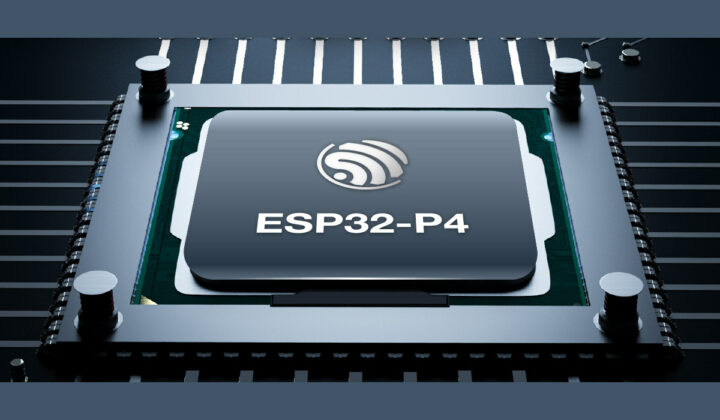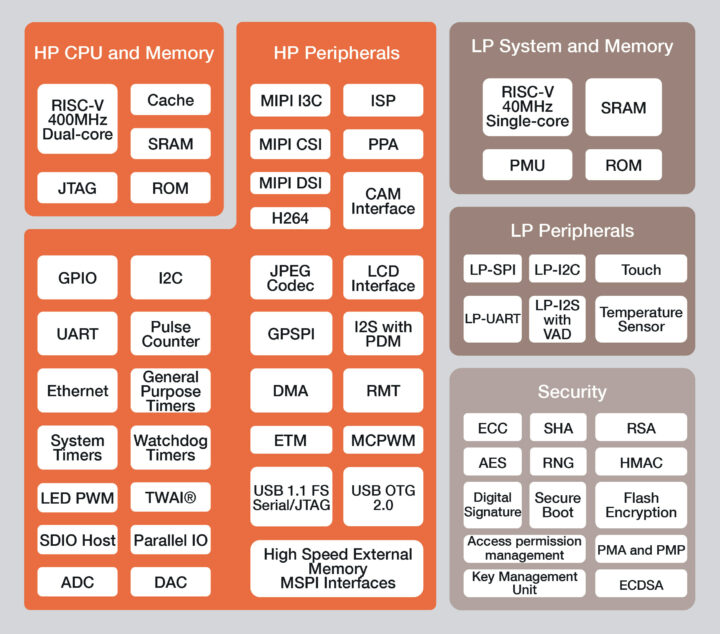Espressif ESP32-P4 is a general-purpose dual-core RISC-V microcontroller clocked at up to 400 MHz with AI instructions extension, numerous I/Os, and security features.
It also happens to be the first microcontroller from Espressif Systems without wireless connectivity, and as such, it should probably be seen as an alternative to STM32F7/H7 or NXP i.RT Arm Cortex-M7 microcontrollers/crossover processors, and likely offered at a significantly lower cost. It should also offer lower power consumption than other ESP32 chips thanks in part to a third RISC-V core clocked at 40 MHz that can keep the system running while the other two high-performance cores are down.
ESP32-P4 key features and specifications:
- MCU subsystems
- Dual-core RISC-V HP (High-performance) CPU @ up to 400 MHz with AI instructions extension and single-precision FPU, 768KB of on-chip SRAM
- Single-RISC-V LP (Low-power) MCU core @ up to 40 MHz with 8KB of zero-wait TCM RAM
- Memory & Storage I/F – Support for external PSRAM and flash
- GPU – 2D Pixel Processing Accelerator (PPA)
- VPU – H.264 and JPEG codecs support
- HP peripherals
- Display I/F – MIPI DSI and parallel LCD display interface
- Camera I/F – MIPI-CSI with integrated ISP and parallel camera interface
- Audio – I2S with PDM
- Networking – Ethernet
- USB – USB OTG 2.0 HS, USB 1.1 FS Serial/JTAG
- SPI, I2C, I3C, LED PWM, MCPWM, RMT, UART, and TWAI
- ADC, DAC
- SDIO Host 3.0 for high-speed connectivity.
- Up to 50x GPIOs
- General-purpose timers, watchdog timers, system timers
- LP peripherals
- SPI, UART, I2C
- I2S with VAD (for wake word detection)
- Touch control
- Temperature sensor
- Security
- Secure Boot
- Flash Encryption
- Cryptographic accelerators for ECC, SHA, AES, RSA, ECDSA
- TRNG
- Digital Signature Peripheral
- Dedicated Key Management Unit
- Access permission management
- PMA and PMP
As noted in the second paragraph the “big-little” architecture will enable ultra-low-power applications which may occasionally require high computing with the HP cores turned off for most of the time in order to save power. Support for 2D graphics acceleration, H.264 & JPEG codecs will make it suitable for human-machine interfaces with machine learning capability and the requirements for a larger number of I/O are made available by current ESP32 chips.
It’s still possible to add wireless connectivity to the ESP32-P4 with one of the ESP-Hosted or ESP-AT solutions, where the ESP32-P4 acts as a host MCU and the other ESP32 chip provides WiFi, Bluetooth, or Zigbee. Espressif will support the new ESP32-P4 through the usual ESP-IDF framework. The new RISC-V microcontroller is not available just yet, but the company tells us to stay tuned for more detailed information in the coming weeks.
Thanks to Adam for the tip.

Jean-Luc started CNX Software in 2010 as a part-time endeavor, before quitting his job as a software engineering manager, and starting to write daily news, and reviews full time later in 2011.
Support CNX Software! Donate via cryptocurrencies, become a Patron on Patreon, or purchase goods on Amazon or Aliexpress







Considering stm32f7 costs about $20, this will surely be a lot more cost-effective. And being able to use esp-hosted to add wireless is a really good selling point. Also, espressif’s API is arguably better than ST’s.
The only thing st platforms have is free access to WYSIWYG gui programming
$20?! that is one more reason to use i.mx RT instead, why are people even bothering with STM32x7 at this point?
i.mx RT also costs about $20 each
32f7 has double precision floating point, I believe. Also better compare the analog stuff.
most M7s have double floats…
Having integrated WiFi would be preferable. Also some specs like H.264 encoder are a bit outdated. Currently H.265 devices are deployed. I really hope they updated the peripherals as well. In the previous editions most of them are limited to 40 MHz speed, very slow for some applications.
MCU with H.265? I’d like to see that please.
Exactly. h.264 is a spectacularly high-end feature for an MCU. Normally you’d expect MJPEG if there’s a video codec at all! The point of a video codec on an MCU is to reduce the lion’s share of the video data bandwidth so that it can communicate it with a low-power bus. If you want modern low-data-rate codecs, you’re talking about an IMU, GPU, or very heavy application CPU, not a bargain-basedment MCU.
Not sure if this can be called MCU, but look at Realtek Ameba Pro 2 RTL8735B – Arm v8M @500MHz, 802.11 a/b/g/n Wi-Fi, H.264/H.265 encoder up to 5MP, AI Engine @0.4 TOPS, The evaluation board Realtek AMB82-Mini is inexpensive $24.99, but currently Out of stock.
I didn’t notice at first that it came without a radio, that’s so uncommon from Espressif! It definitely indicates they’re considering a move towards more general purpose MCUs!
Same. The only reason I’d pay any attention to this is because of their wireless history. As soon as I saw ‘no wireless’, and as the rest of the features scrolled by, I realized this chip wasn’t anything I had any need for. Not my market segment I’m afraid. Bully for Espressif for branching out, but just not for me.
The H264 hardware codec definitely came as a big surprise for me. Can’t wait to see further specs on this thing
what is the OS use?
Linux or RTOS or other?
None or rtos as far as i can tell
It uses the same software stack as all other esp32’s do, so freertos is the way to go
The addition of all the video-related stuff (CSI, DSI, H264…) and the return of Ethernet makes it look a little bit more like a general purpose CPU/SoC (similar to those from Allwinner or Amlogic for instance, though it still lacks a GPU), but it will be interesting to see exactly what kind of support for larger amounts of external RAM they are planing and the resolutions they will support. Despite the removal of wireless capabilities, I wouldn’t be completely surprised if this one were to be more expensive, not less, than other ESP32 variants.
I haven’t seen any other mcus that even remotely compares in performance and peripherals, but stmf7 costs about 20usd each, and this device would blow it out of the water even at the same price.
Awesome to see TCM on this. That’s super handy for writing bit-banging code, as PSRAM is normally cached and caches have unreliable timings.
It looks like only the low power 40mhz core has TCM.
I wonder if they’ll also push a version for safety, with HP cores in dual-lockstep and lp as checker core.
Never mind. There is no CAN peripheral… Maybe could work using EtherCAN, but it’s a long-shot
@andelf twai is canbus compatible
I’m looking forward to seeing how this work out for use in cctv
TWAI == CAN, I guess there is just some funky trademark nonsense going on so they don’t call it that
I think CAN Bus requires a license. TWAI looks to be trademarked too, so I’m not sure what’s the advantage unless the license is cheaper.
Oh, now I can see a thread on GitHub about that very topic.
The CAN Bus API is deprecated in the ESP-IDF, and replaced by the TWAI API.
One of the commenters explains it all:
It looks like TWAI does not support CAN FD however.
If you call it TWAI you don’t have to pay a CAN license fee to Bosch for every part you sell.
Cool! Thanks!
Great to see it’s RISC-V. Will that now be the default for MCU’s?
That’s at least true with all new Espressif microcontrollers. They’ll only be using RISC-V going forward, no more Xtensa cores.
Espressif announced that when they introduced the ESP32-C5.
This article doesn’t mention which RISC-V extensions will be implemented or even whether it is 32- or 64-bit wide. I think that’s because the press release omits this information.
There is a standardized way of referring to RISC-V implementations. I bet that this is RV32I plus a few extensions. M? It does have single precision floating point, so I guess F. There are surely more but they are less easy to guess.
What’s about technology node? 400MHz is a pretty high for mature one.
How does ESP32-P4 stand in comparison to Sipeed LicheeRV with Allwinner D1?
Could be quite intersting on what Esspressif deliver as a dev kit as maybe the might release a dual chip esp32-p4 and another esp32 using ESP-Hosted on single board and wondering how they might choose to implement that?
High efficiency but unusable in most industrial applications
Some ESP32-P4 code was pushed to the ESP-IDF framework last month:
https://github.com/espressif/esp-idf/tree/master/components/soc/esp32p4
The ESP32-P4 should become available very soon . Espressif has been showing an ESP32-P4 board and teasing the new MCU on their social network in the last few days.
Still no product page or purchase links though. But people who contact them directly might be able to get beta samples.